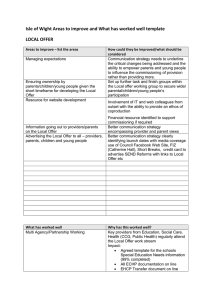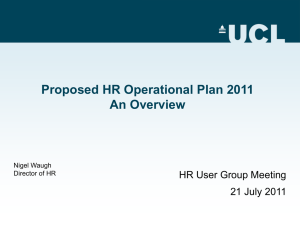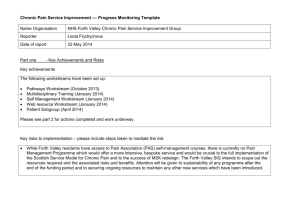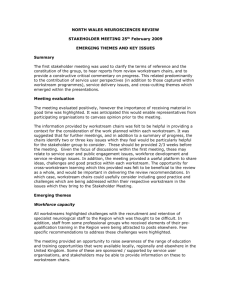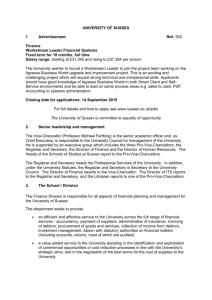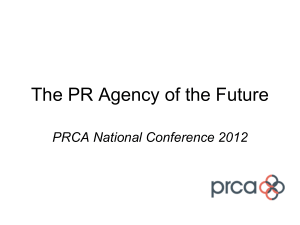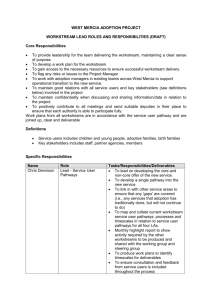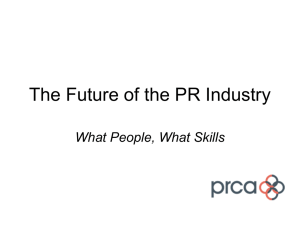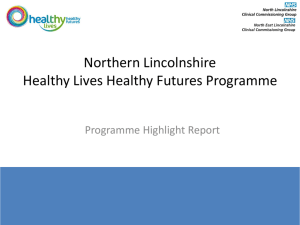User and stakeholder involvement workstream: Final evaluation
advertisement
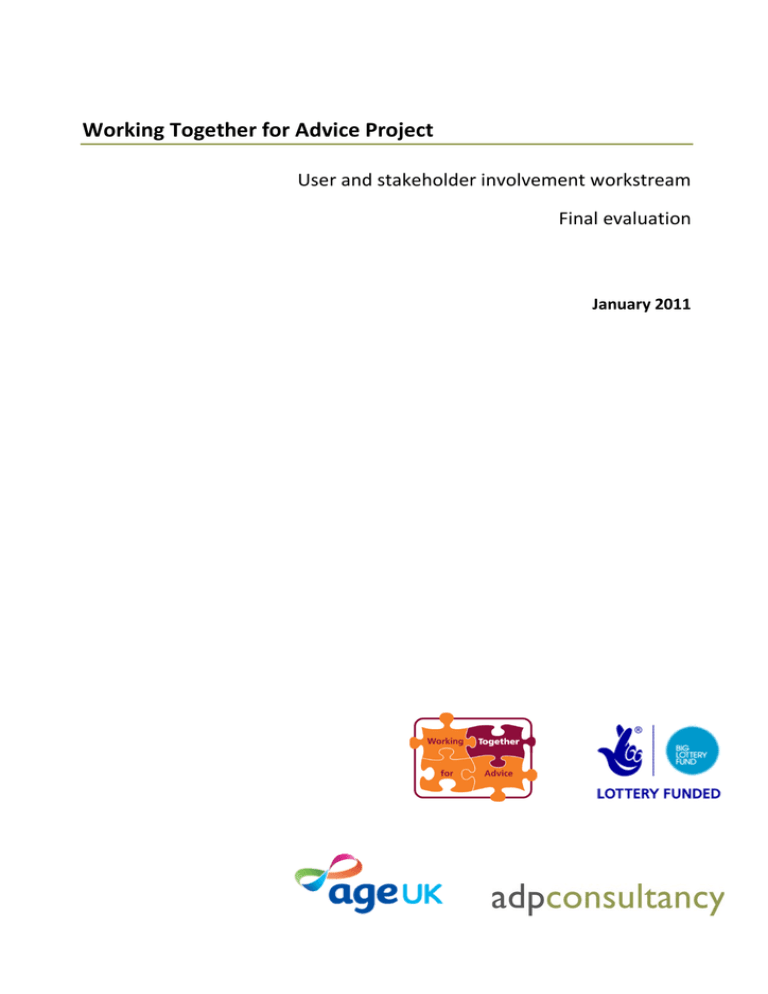
Working Together for Advice Project User and stakeholder involvement workstream Final evaluation January 2011 Contents Section Page 1. Introduction 4 2. Working Together for Advice project 4 3. User and Stakeholder Involvement workstream 4 3.1 Aims of the workstream 3.2 Outcomes, activities and milestones 3.3 Workstream resources 4. Workstream evaluation 7 5. Achieving workstream outcomes 7 5.1 Involve, Engage, Empower toolkit 8 5.2 Training 9 5.3 Promoting user and stakeholder involvement as an essential factor in the development of advice services 10 5.3.1 Levels of User and Stakeholder Involvement in the sector 5.3.2 Communication 6. Findings 14 Appendix I - Workstream milestones ADP Consultancy Working Together for Advice Project January 2011 3 1. Introduction This is the final evaluation report of the Big Lottery funded Working Together for Advice Project’s User and Stakeholder Involvement workstream. The report focuses on whether the workstream achieved both its key aim and the projected outcomes identified at the onset of the project in 2008. It considers the work completed in the final year of the project and also reviews the findings from the first two years of the project. It focuses on the completion of the Involve, Engage, Empower toolkit and the provision of training during the final year. Individual reports covering the first two years of the project are also available. 2. Working Together for Advice project The Working Together for Advice project was a ‘multiple strand project’ set up with funding from the Big Lottery Fund as part of the first phase of the Advice Plus1 programme to ‘provide a range of support services to independent advice centres in England. It was a delivered by a consortium of organisations 2 and aimed to: • • • • • Increase access to advice Enhance the quality of advice Demonstrate the value of advice Improve the efficiency of advice services Build the capacity of the advice sector. The project was divided into eight workstreams that considered specific aspects of the delivery of advice services. These were: • • • • • • • • Developing access to advice Enhancing frontline advice Developing a quality mark Advice outcomes Developing discrimination advice Promoting advice Workforce development and training User and Stakeholder Involvement. The project operated from January 2008 to December 2010. 3. User and Stakeholder Involvement workstream The need for a workstream that focused on user and stakeholder involvement as part of the Working Together for Advice project was based on the experience of members of the consortium who reported receiving requests from their member organisations for assistance in 1 The Advice Plus programme aimed ‘to help people access good quality advice on their legal rights and responsibilities, so that they can overcome disadvantage’. 2 Advice Services Alliance, AdviceUK, Age UK, Citizens Advice, Law Centres Federation and Youth Access. ADP Consultancy Working Together for Advice Project January 2011 4 developing this. In addition, it was recognised that while the voluntary and community sector, generally, had been relatively successful in engaging with users and other stakeholders, this had not necessarily been the case in the advice sector. This is partly explained by the different style of relationship that advice agencies have with their users. While some users may establish long-term relationships with advice agencies the majority of interactions tend to be short-term and time limited in order to address a single or related group of issues and do not necessarily lend themselves to ongoing long term relationships. In addition, advice agencies generally seek to empower their users to address their own issues, this is thought to discourage users from becoming dependent on agencies. However, it also makes it less likely for users to become engaged with an agency in the longer term 3. 3.1 Aim of the workstream The aim of the User and Stakeholder Involvement workstream was to: “Increase user and stakeholder involvement in the management and development of advice services by identifying best practice through research, development of a toolkit and delivering appropriate training.” The terms users and stakeholders were defined for the purposes of the workstream as: Users - individuals with advice needs who do, or potentially could, access, receive and benefit from the services of independent, not-for-profit advice agencies. Stakeholders - organisations or individuals directly involved in the processes by which users access and receive advice. They aim to ensure positive outcomes for users of an advice service, eg referral organisations; families and carers of users and service providers/organisations that users are directed to by advice agencies. 3.2 Outcomes, activities and milestones The workstream identified a number of outcomes as key measures of the success of the project: • • • • • 3 750 voluntary and community sector organisations are better equipped to deliver more effective advice services based on the motivations and needs of advice users and stakeholders Members of Advice Services Alliance (ASA) improve their understanding of user and stakeholder involvement in the development of advice services A minimum of 180 staff in the advice sector improve their ability to effectively involve users and stakeholders in development of services Users of advice services increase their opportunities to influence the planning delivery and management of services The advice sector improves its contribution to policy development on user involvement in the provision of mainstream advice services. ASA Business Plan v4.1, Section 6: Workstream 2 - Users and Stakeholder Involvement ADP Consultancy Working Together for Advice Project January 2011 5 In order to achieve the outcomes the workstream identified a number of core activities and mapped out a series of milestones 4 for each year of the project. The key activities throughout the project were to: • • • • • Research and map existing models of user and stakeholder involvement Develop a draft toolkit and training programme Pilot the toolkit and training with local advice agencies Promote and rollout the toolkit and training across the regions Influence policy development on user involvement in advice service provision. Evaluation of the project throughout the three years has considered the progress of the workstream in completing the planned activities and achieving its original outcomes 3.3 Workstream resources The workstream was co-ordinated by Age UK5 and involved all of the advice networks contributing to Working Together for Advice – Advice UK, Age UK, Citizens Advice, the Law Centres Federation and Youth Access. Representatives from each of the advice networks and Advice Services Alliance formed the Workstream Management Board. The workstream had a Co-ordinator, employed by Age UK, with responsibility for: • Identifying ways to motivate users and stakeholders to be involved, taking into account the range of users across the advice sector. • Reviewing existing good practice, from across voluntary, statutory and private sectors, in user involvement • Developing methodologies to improve user and stakeholder involvement in the development and provision of advice services • Identifying the resources needed by advice services to embed user and stakeholder involvement in their organisation • Developing a toolkit and training for advice agencies on user and stakeholder involvement and using the toolkit • Piloting and adapting a range of user and stakeholder involvement methods with advice agencies • Rolling out training across nine English regions in user and stakeholder involvement and using the toolkit • Co-ordinating the linkage between local level and national level involvement to ensure the user and stakeholder involvement on strategic decisions at national and regional levels. In addition to the Workstream Co-ordinator position AgeUK, the Law Centres Federation and Youth Access received funding to assist in the delivery of the workstream. 4 5 The workstream milestones are listed at Appendix I. Age UK is a charity formed in 2010 following a merger between Age Concern and Help the Aged. The project was previously co-ordinated by Age Concern England. ADP Consultancy Working Together for Advice Project January 2011 6 4. Workstream evaluation The main focus of the evaluation has been on how far the work carried out as part of the workstream has achieved or contributed to: • • • The main aim of increasing user and stakeholder involvement in the management and development of advice services The workstream’s specific outcomes, activities and milestones The Working Together for Advice Project aims and outcomes This report provides details of the workstream’s activities over the three years and how successful it has been in achieving its outcomes. In producing this report we have reviewed the interim evaluation reports completed at the end of years one and two and carried out interviews with the Workstream Management Board representatives from the advice networks and the Workstream Co-ordinator and National Manager, Quality and Partnerships at Age UK. A survey was also circulated to participants of the training carried out in year three in order to obtain their views on how they had been able to use both the skills and knowledge they obtained from the training and the toolkit. Unfortunately, the survey received only five responses, which was considered insufficient from which to obtain any meaningful data. The survey was circulated at a time when advice agencies were concerned with more pressing issues. Agencies are currently operating in an environment where they are extremely concerned about their future funding. Ongoing changes to the provision of services funded by legal aid and threats to both funding from that source as well as threats to other funding, particularly that from local authorities at this time, means that it is more difficult than usual to get agencies to engage with new developments, such as the user and stakeholder involvement work, at a time of massive uncertainty for many agencies across the country. This is the final of three evaluation reports focusing on the work of the project. The first year report focused on the development stage of the project and reported on progress on the main activities and achieving the project outcomes. In Year Two the focus was on the pilot agencies and the development of the toolkit. This report reviews the work carried out in the first two years and that completed during the final year and how successful the workstream has been in achieving its outcomes. 5. Achieving the workstream outcomes This section of the report focuses on the main activities that the workstream was tasked to deliver in order to achieve the outcomes. The main activities were to: • • • • • Research and map existing models of user and stakeholder involvement Develop a draft toolkit and training programme Pilot the toolkit and training with local advice agencies Promote and rollout the toolkit and training across the regions Influence policy development on user involvement in advice service provision. The report focuses on four key elements of the workstream: ADP Consultancy Working Together for Advice Project January 2011 7 • • • • The production of the toolkit Involve, Engage, Empower The delivery of training on implementing user and stakeholder involvement Promoting user and stakeholder involvement as an essential factor in the development of advice services Influencing policy. Each of these is considered in relation to their contribution to achieving the workstream outcomes. In the Year One Interim Evaluation report the workstream activities were broken down into those that assisted progress towards better involving users and stakeholders in delivering more effective advice services and those that influenced policy. We have used this method again here in relation to reporting against how successfully the workstream has achieved its outcomes. 5.1 Involve, Engage, Empower toolkit The production of the Involve, Engage, Empower toolkit was one of the main activities identified for the workstream. The final version of the toolkit consists of a set of resources and exercises aimed at enabling ‘local information and advice providing organisations to embed user and stakeholder involvement in the management and development of their services’. The toolkit has six main sections and includes a brief introduction on how to use it. The opening section defines user and stakeholder involvement and offers suggestions for why organisations should involve users and stakeholders. The following five sections provide information and practical exercises to assist organisations develop user and stakeholder involvement that cover: • • • • • Reviewing levels of involvement Developing a strategy for involvement A range of methods of involvement Policies and procedures for involvement Skills and knowledge - building capacity and confidence among the involvement audience. The toolkit has been distributed to advice network members and is available in both print and downloadable versions. Feedback from the network representatives has been fairly positive about the final version of the toolkit. Both Citizens Advice and AdviceUK have received requests for hard copies of the toolkit from member organisations and report that feedback from members has generally been positive. During the development of the toolkit the Workstream Management Board raised concerns about the way that the initial toolkit had been developed particularly an overemphasis on the theoretical aspects of user and stakeholder involvement. This was also raised by the pilot agencies who reported difficulties in practically applying the contents of the toolkit. It appears that while some of the Management Board still raised issues about the length of time taken to produce the toolkit during the final interviews the majority of concerns raised about the draft version used during the pilot stage have been addressed and the workstream has delivered a practical tool that is likely to be of benefit to advice agencies. ADP Consultancy Working Together for Advice Project January 2011 8 There is currently no feedback from agencies from across the advice networks about their practical use of the toolkit. The work with the pilot agencies highlighted the need for considerable lengths of time needed for agencies to adopt new processes and procedures and the late production of the final version of the toolkit has not allowed for this to be monitored as part of the evaluation The process for developing the toolkit included a review of good practice in involving users and stakeholders from across the voluntary, statutory and private sector. This was completed during the first year of the workstream and included a review of identified literature and a series of meetings with agencies both from within the advice sector and externally. It resulted in a collection of material collated by the Workstream Co-ordinator that influenced the structure of the Involve, Engage, Empower toolkit 6. The review of good practice took up a considerable amount of time during the first year of the project. Discussions with the Workstream Management Board and the Workstream Coordinator suggest that the workstream could have been more effective in terms of getting things in place, such as the toolkit and training, had this been done more quickly. Delays in delivering on this element of the project had a knock on effect on the delivery of the other main activities such as the production of the toolkit, the start of the pilot phase and the delivery of the training. As a result this has left insufficient time to obtain the views of advice agencies on how they have used the resources developed by the workstream to develop their user and stakeholder involvement. The workstream has developed a useful tool for advice agencies to develop their use of user and stakeholder involvement. Testing the initial draft toolkit with the pilot agencies enabled changes to be made to the draft version to ensure a practical tool was produced that could be used by advice agencies. Now that the Working Together for Advice project has ended and the Workstream Co-ordinator role will not continue it is important that advice networks consider how they might continue to support their members to develop their work in this area. A number of important policy developments and an increasing emphasis, particularly on user involvement, by advice funders, such as local authorities is likely to ensure that this remains a significant area of development for the advice sector. 5.2 Training At the planning stage those involved in developing the workstream also identified the provision of training as one of the key mechanisms for increasing the use of user and stakeholder involvement in the advice sector. The initial idea was to deliver a pilot training course to the pilot agencies and adapt the training based on feedback and then roll out the training across the nine English regions. It was anticipated that this would be available to up to 20 participants in each region from across the advice networks and would contribute to achieving the workstream outcome to improve the ability of advice sector staff to effectively involve users and stakeholders. As a result of delays in the production of the toolkit the delivery of the training was also delayed. Training started in July 2010 and as delivered four events in the Eastern, East Midlands, North West and South West regions. Discussions with the Workstream Co-ordinator have highlighted 6 A list of the good practice resources and contributors is at Appendix E of the Year One Evaluation Report. ADP Consultancy Working Together for Advice Project January 2011 9 that the training has primarily been attended by staff from local Age Concerns and has not been promoted to other advice network staff. Separate training has been carried out for its members by Youth Access in partnership with two external organisations Participation Works and Independent Academic Research Studies on getting started with participation and conducting research with young people. Feedback from the training events collected immediately following the event indicates that participants have found the training to be useful. However, the feedback is fairly limited and there is no information available on what agencies attending the training intend to do with the skills and knowledge obtained. It would have been useful to get an indication from agencies about how they intended to develop user and stakeholder involvement. This could then have been followed up at a later date to establish what, if any, progress agencies had made. Delays in organising the training and the lower than expected attendance, along with the concentration of training across only two of the networks, limits the usefulness of the data that is available. Discussions with the Workstream Management Board suggest that they believe their members would still benefit from training in this area. However, there was recognition that in the current environment, with agencies unclear about their future, within the advice sector take up of training might be limited. We would suggest that in order not to lose some of the momentum established through the workstream that there may be an opportunity to develop alternative training and promotion methods such as online workshops in order to train agencies in this area of work. We recognise that within the current financial climate this may be difficult to achieve but an increase in requirements by funders to involve users may present an opportunity to obtain resources to deliver this. The diverse nature of the sector and the networks does not always lend itself to joint working. The different sizes of organisation, the different client groups, different local and regional priorities can make it difficult to develop a one size fits all solution such as training. Organisations with a specific client group such as Age UK and Youth Access are perhaps better positioned to have been able to develop processes and engage with their users. A number of policy initiatives aimed specifically at the involvement of both young people and older people in service delivery give a focus to work with particular groups which agencies working with more general populations are not always able to take on. We consider that the use of training to promote user and stakeholder involvement has only had limited success through the workstream and while those that have accessed it suggest it has been useful it has not managed to deliver a sector-wide package of training that can be used across the different networks. 5.3 Promoting user and stakeholder involvement as an essential factor in the development of advice services 5.3.1 Levels of user and stakeholder involvement within the sector In order to establish where advice agencies were in relation to the involvement of users and stakeholders in the management and development of their services, agencies and users were surveyed and a series of short telephone interviews carried out with advice agencies. The surveys considered the motivations and barriers to involvement from the perspective of the agencies themselves and their users. During years one and two interviews were carried out with ADP Consultancy Working Together for Advice Project January 2011 10 agencies with the intention of revisiting agencies in the final year to see how they had used the resources developed by the workstream to progress their work on user and stakeholder involvement. The delays in the production of the toolkit and the training as not allowed the final interviews to be carried out, however, some of the information gathered provides a useful outline of work in the sector. The agency survey highlighted that 90% of agencies responding (30 agencies) said they involved users and stakeholders in managing and developing their services. The main ways they did this was through the use of satisfaction surveys; users becoming members of the management committee and participating in group meetings to discuss service development, such as away days, planning days, focus groups and liaison groups. Agencies suggested that their main motivation for involving users was to ensure that the services they provided met users need. Almost 70% of respondents to the user survey said that they thought it was important for people who use local advice services to be involved in the way services are delivered. They considered that this could: empower users; improve workers understanding of users needs; help improve service; give something back to the community, generate new ideas; improve access and help others through sharing experiences. One issue that was highlighted in both the surveys and discussions with advice agencies and network representatives was the emphasis on users to the virtual exclusion of other stakeholders. The first year evaluation suggested that Workstream Management Board should consider whether this was an issue for the workstream and if so how the involvement of other stakeholders needs to be considered further. The emphasis on users has continued throughout the workstream. Although the resources provided in the toolkit could as easily be used to engage with other stakeholders and some other stakeholder engagement is evident the main focus has been on users. Discussions with the Workstream Management Board in the final year suggest that user and stakeholder involvement remains a key issue for the advice sector. This is partly due to an increased emphasis on it by current and potential funders or advice services and increasing awareness from both within advice agencies and from users of their need to be involved in ensuring that services meet their needs, as part of general shift in increased involvement. The issues of different styles of engagement with users that advice services have, which can often be short-term and issue specific, continues to be an issue for the sector to maintain ongoing involvement and engagement with its users. 5.3.2 Communication Ensuring effective communication and disseminating the workstream resources to the advice networks was an important part of the function of those involved in the workstream, particularly the network representatives on the Workstream Management Board and the Workstream Co-ordinator. Throughout the different evaluations we have considered how effective the workstream communication has been across a number channels including the Workstream Management Board with frontline agencies and also across the other workstreams operating as part of the Working Together for Advice Project. Throughout the first two years of the project the Workstream Management Board generally reported that communication across the workstream and with the Workstream Co-ordinator ADP Consultancy Working Together for Advice Project January 2011 11 had generally been effective. Members considered the Board Meetings to be a useful mechanism and the information provided by the Co-ordinator enabled them to contribute to the management of the workstream effectively. In the final interviews with the Board Members a number said that they felt that the communication had deteriorated towards the end of the project. Members who raised this were unsure why this had happened but suggested that the extension of the project beyond the scheduled time had made it more difficult for them to be involved as other priorities began to take precedence. The issue of allocating sufficient time to the workstream was raised throughout the project. Some of the network representatives were involved in a lot of the different workstreams and allocating sufficient time to each one was sometimes difficult. This was particularly the case where a network representative had a more significant role in another workstream. In addition, only some of the networks were provided with resources to be involved and this led to those not receiving resources concentrating on those workstreams they were funded to participate in. One of the key relationships for the workstream was with the frontline advice agencies. There were some concerns raised early on that communication with these agencies overly relied on the ability and capacity of the respective network representatives to communicate effectively with their members and on the Workstream Co-ordinator to ensure information was available. This could result in agencies getting different messages about the work dependent on which network they were a member of. An initial response to this was to get the Workstream Coordinator to take a more active role in direct communication or to produce clear guidance to ensure commonality of the message. This was developed throughout the second year of the project but appears to have fallen away during the final year with network representatives reporting only limited communication following production of the toolkit. A further issue identified was that in the same way that the network representatives had competing priorities for their time this was the same for the advice agencies. The workstream was not only competing with the other project workstreams for advice agency time but also with agencies need to deliver their existing services. The work with the pilot agencies and discussions with the network representatives highlight the amount of time and support required by agencies in order to implement new processes can prevent them being implemented as other priorities take precedence. 5.4 Influencing policy At the time of developing the workstream there was recognition throughout the advice sector of the increased need to involve people in deciding how they wanted to resolve their problems and how services needed to change to reflect the needs and wishes of service users. This continues to be an issue for advice agencies, the introduction of the Duty to Involve in 2009 and current policy developments following the change of government in 2010, such as the development of the Big Society idea and the increased emphasis on localism, through the Localism Bill, are likely to ensure that the involvement of individuals and local communities in service delivery continues to remain an issue for the advice sector. There is limited evidence of the extent to which the advice sector as a whole has been involved in influencing policy although some of the individual networks report significant developments in their areas of work. As highlighted earlier this is particularly prevalent for agencies working with specific client groups. ADP Consultancy Working Together for Advice Project January 2011 12 5.5 Barriers The initial surveys of agencies and users and the work with the pilot agencies identified a number of barriers that faced agencies and users in getting involved with advice services. The main issue for agencies tended to be the amount of time available to put things in place. This is partly explained as the majority of organisations were starting from a point where they had fairly limited experience of user involvement. The second year evaluation discussed the barriers with the pilot agencies and identified a number of barriers, in addition to the issues with time, these included: • limited staffing resources to implement • the reliance on one worker to take responsibility within the organisation • a lack of understanding across the organisation of the need for involvement • external personal factor • competing priorities for time • effects of increased demand for information and advice services during the recession, particularly for debt advice services. The second year evaluation highlighted that realisation of the amount of time needed to develop processes and methods for involvement would have resulted in the pilots being done for longer than the six-month period as it was generally agreed that there was insufficient time for agencies to be able to put in place involvement at the levels that were expected when the pilot started. As well as barriers for agencies in taking on involvement the surveys carried out in year one also identified barriers that prevented users getting more involved. These included: • • • • • People having other commitments Competing priorities Convincing users that their contributions will be valued Lack of training available Confidentiality issues As indicated earlier there is currently a focus on people getting more involved in their communities and local areas. This could potentially either make it more difficult for agencies to attract users to be involved or increase awareness and confidence amongst users and put greater pressure on agencies to adopt effective processes to ensure involvement and participation from their users. Agencies will need to ensure they get the balance right between getting people involved and not putting unrealistic demands on their time. ADP Consultancy Working Together for Advice Project January 2011 13 6. Findings 6.1 The workstream has either fully or partially completed all of the key activities identified at the start of the Working Together for Advice Project. The workstream has made progress towards achieving its outcomes. There is, however, limited evidence of the difference that this has made to advice agencies in making progress towards better involving users and stakeholders to deliver more effective advice agencies 6.2 The main issue for agencies developing involvement is the amount of time required to develop systems, engage with stakeholders and begin to identify the results of involvement. In addition, the current economic environment is not currently conducive to agencies developing new areas of work. There is concern that this may be detrimental to organisational development as there is potential for user involvement in particular to become an increasing priority for funders. 6.3 The sector now has a toolkit available that can help advice agencies effectively engage with their users and other stakeholders. The process of developing the toolkit and testing a draft with pilot agencies was particularly beneficial in getting a practical resource that can be used by advice agencies. 6.4 The use of training to promote user and stakeholder involvement has only had limited success through the workstream and while those that have accessed it suggest it has been useful it has not managed to deliver a sector-wide package of training that can be used across the different networks. 6.5 Evidence of the change that the workstream has made to advice agencies in the area of user and stakeholder involvement at this stage is lacking. This is partly due to insufficient time to measure the effectiveness of the resources produced due to initial delays in progressing the toolkit and training elements of the workstream. Too much time was spent research and mapping existing resources which resulted in delays throughout the workstream. 6.6 There is limited evidence that the advice sector as a whole has resources and processes in place to encourage adoption of user and stakeholder involvement across the sector. Only members of two of the networks have received training. 6.7 Communication across the workstream has been mixed. The Workstream Management Board worked well throughout the majority of the project as a result of this. However, this changed as the project came to a close with Management Board members reporting limited contact in the final stages of the project. Communication with frontline agencies was perhaps overly reliant on the network representatives and would have benefited from a more co-ordinated approach across the workstream. 6.8 The nature of the relationships between advice services and its users which are often short-term and issue related can make it more difficult than other services to ensure ongoing contact and encourage involvement to the level required to influence service development. ADP Consultancy Working Together for Advice Project January 2011 14 6.9 Both advice agencies and users and stakeholders face a number of barriers that need to be overcome in order to ensure effective user and stakeholder involvement. 6.10 User and stakeholder involvement is likely to become increasingly important for advice agencies as both funders and policy and decision makers place increased emphasis on engaging with individuals and communities in service delivery. The involvement of users and other stakeholders in service development should be a key element for advice agencies. ADP Consultancy Working Together for Advice Project January 2011 15 APPENDIX I Workstream milestones The workstream set a series of milestones to help ensure that the outcomes were met and the activities completed. The following tables show the milestones for the project broken down by year. • Year one milestones Milestone Recruit and induct workstream staff Establish workstream board, draft terms of reference and host board meetings Timescale (Quarter) 1-2 1-2 and then quarterly Recruit independent evaluator 1-2 Select 40 advice agencies for survey 1-2 Begin review of existing good practice from across the voluntary, statutory and private sectors 2-3 Design questionnaire and conduct survey to gather information from across the advice sector regarding motivations of users and stakeholders 2-3 Establish workstream steering group, draft terms of reference and host group meetings 3 and then quarterly Begin independent evaluation of the workstream 3 Completed questionnaires received from users and stakeholders 3 Review of existing good practice in stakeholder involvement completed 3 Analysis of user and stakeholder motivation completed 4 Analysis of and development of methodologies to improve user and stakeholder involvement completed 4 Report for ASA members on user and stakeholder motivations and recommendations 4 Begin draft user involvement toolkit for pilot 4 Interim report on independent evaluation of the workstream 4 Review milestones for remainder of workstream period and agree amended and/or additional milestones 4 ADP Consultancy Working Together for Advice Project January 2011 16 Milestone Timescale (Quarter) Submit workstream monitoring reports to grant funder Quarterly Submit workstream financial monitoring reports to grant funder Quarterly • Year Two Milestones Milestone Timescale (Quarter) Publish report on findings to increase advice sector’s contribution to policy development on user involvement 5 Complete draft user involvement toolkit for pilot 5 Agree monitoring process for assessing pilot 5 Recruitment minimum of 5 local advice agencies for pilot 5 Training on using toolkit provided to pilot agencies 6 Begin 6 month pilot 6 Pilot agencies submit progress reports on how user involvement has increased 7 Identify resources required by agencies to embed user and stakeholder involvement 8 6 month pilot completed 8 Publish interim report on pilot 8 Produce updated toolkit 8 Produce promotional booklet (short guide to user and stakeholder involvement) to be distributed to advice agencies through all ASA members 8 Interim report on independent evaluation of the workstream 8 • Year Three Milestones Milestone Timescale Pilot agencies submit final reports 9 Independent evaluation of pilots completed 9 Toolkit made available for download from Advice Services Alliance website, with hard copies available for agencies without internet access 9 ADP Consultancy Working Together for Advice Project January 2011 17 Milestone Timescale Toolkit and training on its use promoted through Advice Services Alliance members, with promotional booklets sent to all agencies 9 Training in using toolkit update and developed 9 Training sessions begin - to be run for up to 20 participants in all 9 English regions 10 Training completed 11 Independent evaluation of whole workstream completed 11 Final workstream report produced and distributed 11 750 advice agencies better equipped to deliver more effective advice services based on the needs of advice users and stakeholders 11 ADP Consultancy Working Together for Advice Project January 2011 18 Written by: David Garner, ADP Consultancy © Age UK/ADP Consultancy www.adpconsultancy.co.uk If you require more information about the Working Together for Advice User and Stakeholder Involvement Workstream please contact: Matthew Pilkington Age UK Astral House 1268 London Road London SW16 4 ER Telephone: 020 8765 7748 Email: matthew.pilkington@ageuk.org.uk www.ageuk.org.uk January 2011 ADP Consultancy Working Together for Advice Project January 2011 2
